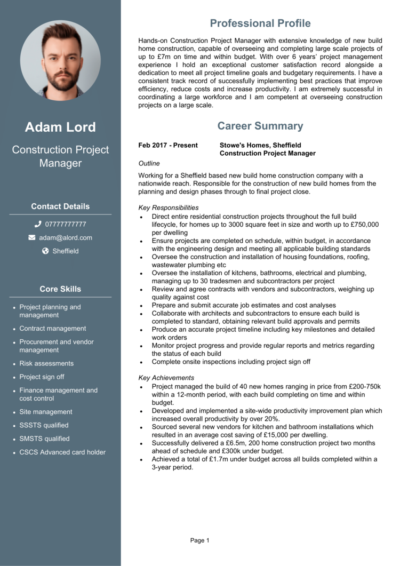You know how to build solid structures, lay strong foundations, and keep things running smoothly. Now it’s time to do the same for your CV.
Employers aren’t just looking for someone who can swing a hammer – they need professionals who can keep projects moving on time and on budget.
This guide and its Construction CV examples will help you construct an application that highlights your skills and experience so you can land your next job with confidence.
Construction Project Manager CV
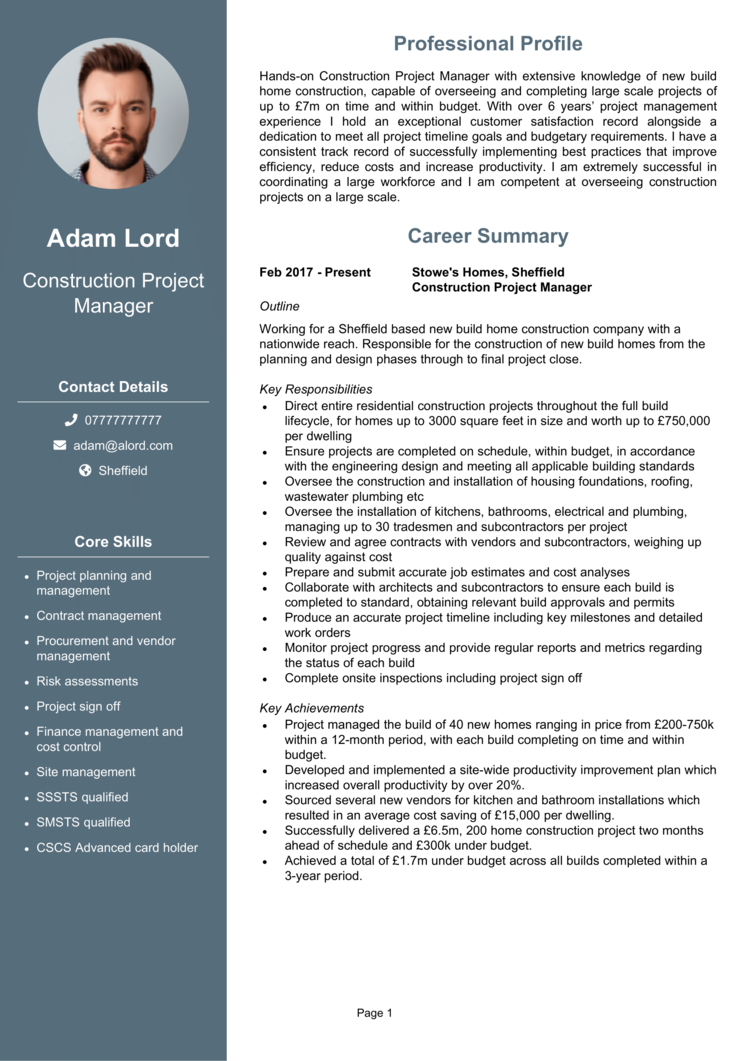
Electrician CV
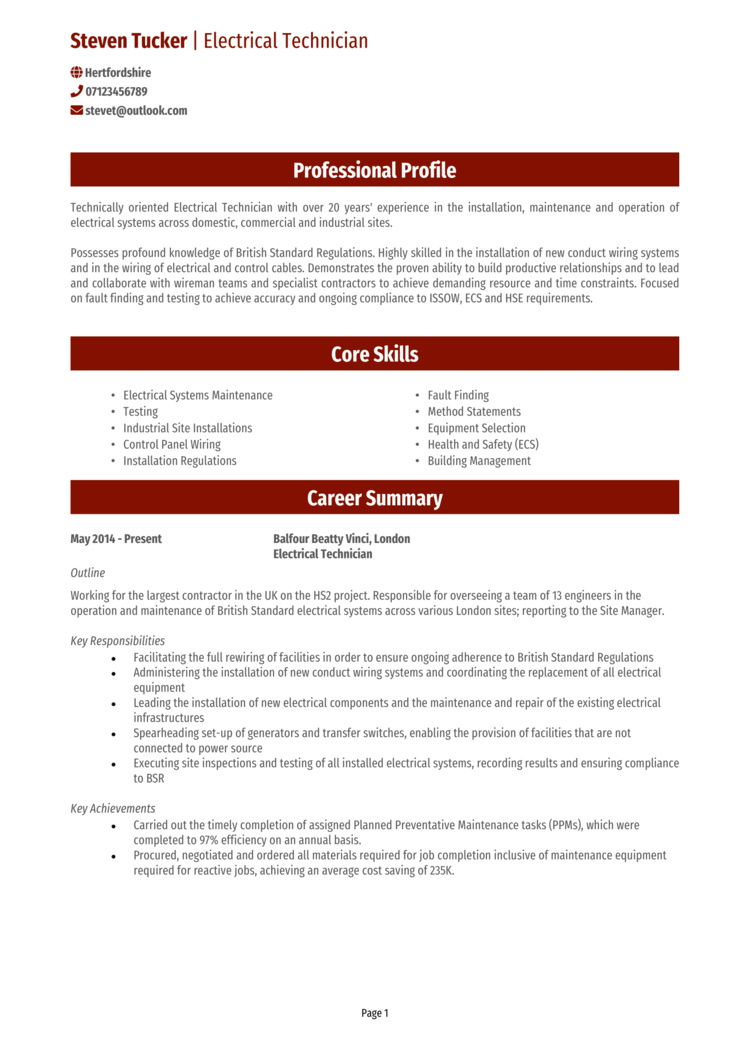
Site Manager CV example

Surveyor CV example
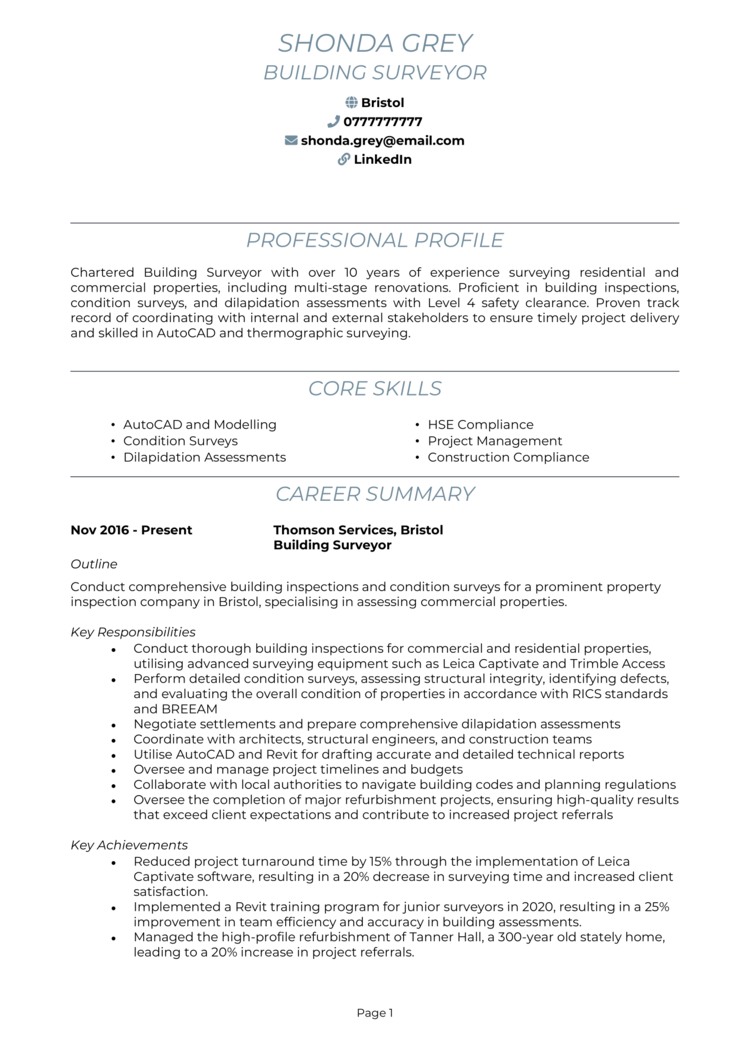
Construction Worker CV example
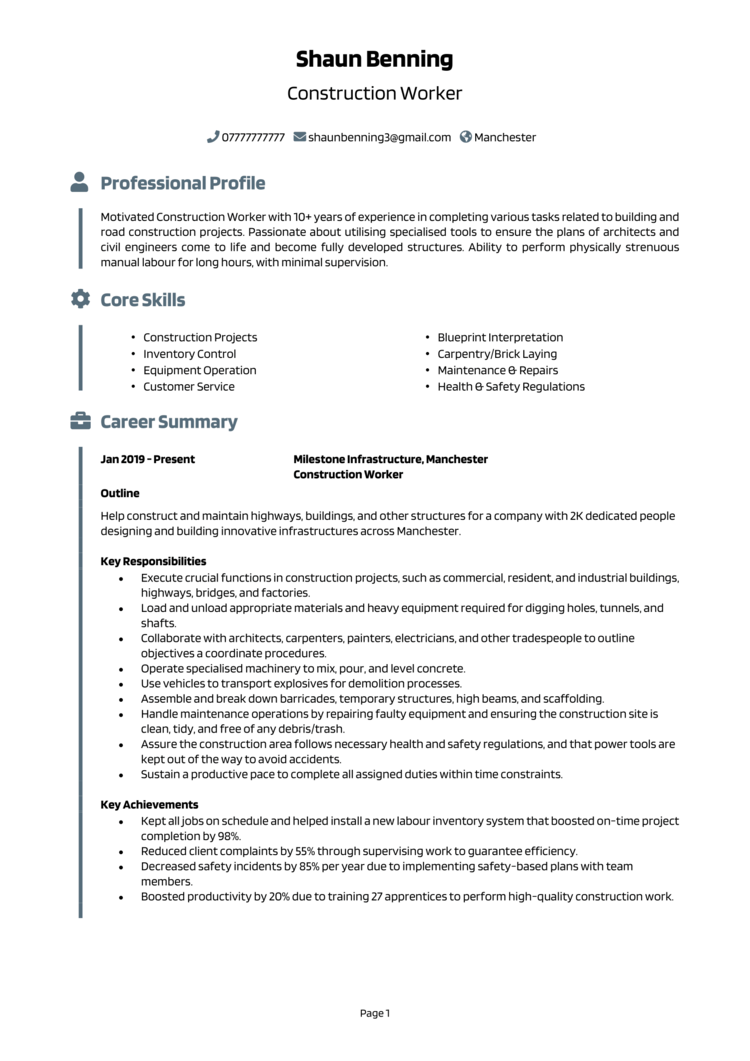
How to write your Construction CV
Learn how to create your own interview-winning Construction CV with this simple step-by-step guide.
When you’re writing a CV, you need to consider what’ll make things easiest for recruiters to find and understand the key information.
This guide will walk you step-by-step through how to format your CV, showcase your skills, and present your experience in a way that ensures hiring managers see you as the right person for the job.
Structuring your Construction CV


In construction, a strong framework is key – your CV should follow the same principle. If hiring managers have to dig through your CV like it’s a pile of rubble, they’ll move on to the next candidate. A coherent layout will help them identify the qualities that make you the right candidate.
Here’s the structure you should follow:
- Name and contact details – Display your personal details clearly at the top so employers can get in touch easily. Including a photo of yourself is entirely optional.
- Profile – Begin with a concise summary that highlights your expertise and what you bring to the role.
- Core skills – Highlight your strongest skills, such as site preparation, equipment operation, and health and safety compliance, that align with the role’s requirements.
- Work experience – Start with your most recent role and work backwards, showcasing achievements and responsibilities.
- Education – Mention your degree, certifications, and any training that supports your career path.
- Additional info – Include any additional details, like hobbies, awards, or memberships, that highlight your skills or personality.
Construction CV format


A messy CV format is like a poorly planned worksite – disorganised and hard to navigate. Keep your application clean, structured, and easy to read, so formatting mistakes don’t overshadow your genuine skills.
Follow these formatting tips:
- Bullet points – These help recruiters skim through your accomplishments quickly and easily.
- Divide sections – Break your CV into distinct sections with clear headings for smooth navigation.
- Use a clear and readable font – Use a simple, professional font and keep your layout uncluttered for maximum readability.
- No more than 2 pages – This is enough length to highlight your expertise while keeping the recruiter interested.
Creating a strong Construction CV profile


Your CV profile is your chance to introduce yourself as a skilled construction professional. Think of it as your blueprint for success: you’ll need to convince recruiters that hiring you would bring tangible benefits to their projects.
Construction CV profile examples
Profile 1
Hardworking Construction Labourer with two years of experience assisting in residential and commercial building projects. Skilled in site preparation, material handling, and operating basic construction tools. Knowledgeable in safety procedures and committed to maintaining a productive and hazard-free work environment. Works well in team-based settings and adapts quickly to new tasks.
Profile 2
Reliable Construction Worker with experience in general labour, groundwork, and assisting tradespeople on-site. Adept at following blueprints, transporting materials, and maintaining equipment. Physically fit and capable of working in demanding conditions while ensuring efficiency and adherence to safety regulations. Eager to develop skills in carpentry and structural work.
Profile 3
Experienced Construction Operative with over five years of expertise in site work, assisting in concrete pouring, scaffolding, and demolition tasks. Skilled in operating power tools, following health and safety guidelines, and working alongside skilled tradespeople. Dedicated to meeting project deadlines while ensuring quality workmanship and site safety.
What to include in your Construction CV profile
These are the things you should include in your profile:
- Construction experience – Whether you specialise in residential, commercial, or industrial construction, highlight your area of expertise.
- Key skills – Mention abilities such as carpentry, plumbing, site management, or scaffolding.
- Safety and compliance – Employers want professionals who follow regulations and work safely.
- Project involvement – Highlight major builds you’ve contributed to, from housing developments to large-scale infrastructure projects.
- Equipment and tools – Mention any heavy machinery, power tools, or specialist equipment you’re trained to use.
Core skills section


A core skills section gives employers a quick look at your abilities. It should bullet point a few key skills that recruiters are actively looking for when they open up an application.
Since construction covers many specialisms, tailor this section to match the job description. If the role focuses on site management, highlight leadership, scheduling, and compliance. If it’s hands-on work, focus on your trade skills and certifications.
Key skills that make a Construction CV stand out
- Site Preparation and Setup – Ensuring construction sites are properly organised, safe, and ready for work.
- Blueprint Reading – Interpreting architectural and engineering drawings to follow project specifications accurately.
- Masonry and Concrete Work – Laying bricks, pouring concrete, and constructing foundations with precision.
- Carpentry and Framing – Cutting, assembling, and installing wooden structures such as walls, roofs, and frameworks.
- Plumbing and Electrical Basics – Assisting in installing pipes, wiring, and other essential utilities.
- Heavy Machinery Operation – Using equipment like excavators, forklifts, and cranes safely and efficiently.
- Health and Safety Compliance – Following regulations and safety protocols to prevent workplace accidents.
- Welding and Metalwork – Fabricating and securing steel structures, beams, and reinforcements.
- Site Surveying and Leveling – Measuring and marking land to ensure accurate construction alignment.
- Project Coordination – Collaborating with engineers, architects, and contractors to ensure smooth project execution.
How to highlight work experience


Your work experience should clearly show how you’ve applied your skills on construction sites. Recruiters want more than job titles: they want proof that you can turn plans into reality. Show the projects you’ve worked on, the tasks you handled, and how your work contributed to overall site operations.
List roles in reverse chronological order, ensuring each entry is structured with bullet points. If you’re new to the industry, include apprenticeships, internships, or any relevant hands-on experience.
How to structure jobs

- Outline – Introduce the company, your role, and the types of projects you worked on.
- Responsibilities – List key tasks, such as site preparation, structural work, or safety compliance. Use power words like “constructed”, “installed”, and “supervised”.
- Achievements – Highlight measurable results, such as project completion times, cost savings, or safety improvements.
Example jobs for Construction
Construction Labourer | UrbanBuild Contractors
Outline
Assisted in the construction of residential and commercial buildings for a construction firm, performing essential site duties to support tradespeople and ensure smooth project progress.
Responsibilities
- Prepared construction sites by clearing debris and setting up materials for work crews.
- Transported and organised building materials, ensuring they were readily available for tradespeople.
- Operated hand and power tools safely to assist with structural work.
- Followed health and safety regulations, wearing protective equipment at all times.
- Worked closely with site supervisors to ensure projects remained on schedule.
Achievements
- Helped complete a large-scale housing project three weeks ahead of schedule.
- Recognised by site managers for strong work ethic and teamwork.
- Reduced material waste by 15 percent through better organisation and handling.
Construction Assistant | Titan Infrastructure
Outline
Supported construction teams in groundwork, excavation, and foundation laying at a civil engineering company, contributing to large-scale infrastructure projects such as roads, bridges, and public buildings.
Responsibilities
- Assisted in digging trenches and laying foundations for roads and buildings.
- Loaded and unloaded materials, ensuring correct placement and storage.
- Worked with heavy machinery operators to ensure safe and efficient site operations.
- Maintained tools and equipment, conducting basic repairs when necessary.
- Helped enforce safety protocols, ensuring all site workers followed regulations.
Achievements
- Contributed to a major city road expansion project, maintaining a 100 percent safety record.
- Improved efficiency by implementing better material handling processes.
- Recognised for adaptability and willingness to take on new challenges.
Construction Operative | Summit Builders Ltd
Outline
Performed a variety of skilled and semi-skilled construction tasks for a building and renovation contractor, supporting tradespeople in structural work, refurbishments, and new developments.
Responsibilities
- Assisted in carpentry, bricklaying, and plastering tasks under the supervision of senior tradespeople.
- Installed insulation and drywall, contributing to energy-efficient building projects.
- Set up and dismantled scaffolding safely, ensuring compliance with height regulations.
- Mixed and poured concrete for foundations, flooring, and paving.
- Maintained a clean and organised worksite, reducing hazards and increasing efficiency.
Achievements
- Completed training in advanced power tool operation, increasing site productivity.
- Played a key role in finishing a large office renovation project ahead of deadline.
- Recognised for quality craftsmanship and attention to detail in finishing tasks.
Education section


Construction is an industry where hands-on experience is key, but relevant qualifications can still give you an edge.
List any formal education, apprenticeships, or trade qualifications, starting with the most recent. If you’ve completed specialist courses in health and safety or equipment operation, include them here.
Most valuable qualifications for Construction
- NVQ (National Vocational Qualification) in Construction – A widely recognised qualification for various trades.
- CSCS (Construction Skills Certification Scheme) Card – Essential for proving safety awareness on UK construction sites.
- CPCS (Construction Plant Competence Scheme) Certification – Required for operating heavy machinery.
- SMSTS (Site Management Safety Training Scheme) – Valuable for site managers and supervisors.
- Apprenticeship in Construction or a Trade – A great way to gain hands-on experience and recognised training.


